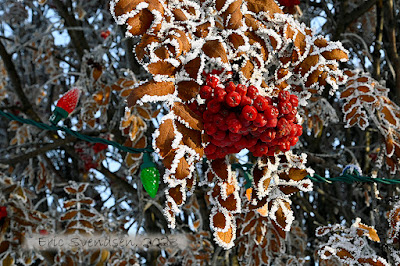Hoarfrost versus Rime Ice. What's the difference?
 |
| Hoarfrost on a mountain ash tree, Leduc, Alberta. |
Deposition is the process of a gaseous vapour turning directly into a solid without the substance ever entering a liquid phase. A good example of this occurs when a frozen mug is removed from a freezer (the colder, the better) and a frosty coating starts to appear on the surface. Water vapour in the warm air touches the frozen glass and becomes a solid. The opposite of deposition is sublimation.
Solidification is the process of a liquid turning into a solid. Forming ice cubes in a freezer relies on the fact that liquid water will freeze when the temperature drops below the freezing point. The opposite of solidification is melting.
Both processes are involved in the crystallization of water on surfaces that are lower than the freezing point. The difference depends on the original state of the end product. Hoarfrost occurs when water vapour in the air undergoes deposition on the surface of frozen substrates. The process often produces crystals that grow over time. In order for the crystals to grow, the atmosphere has to be near 100% humidity, otherwise, any crystals that form will turn back to water vapour through the process of sublimation. If the temperature is above zero, it's dew that forms due to condensation.
Rime ice occurs when sub-zero liquid water comes into contact with suitable substrates. It can come from fog (made of tiny water droplets that are suspended in the air) or freezing rain. When temperatures are below zero, the water particles in fog exist as a super-cooled liquid. It instantly freezes into a solid when the droplet touches a frozen surface. This is a slow process producing crystals that grow over time. If super-cooled water falls as freezing rain, it instantly freezes upon contact. Crystals do not form; instead, the surfaces become encased in a solid coat of ice. Both of these involve solidification.
Both hoarfrost and rime ice can be stunningly beautiful. They can also be destructive and dangerous. Slippery surfaces invite falls and accidents; the added weight to branches risks the destruction of foilage. The degree of risk and damage depends greatly on the amount of water attaching to the surfaces. Either way, photography opportunities abound.
Thanks for reading.
Eric Svendsen www.ericspix.com



Comments
Post a Comment